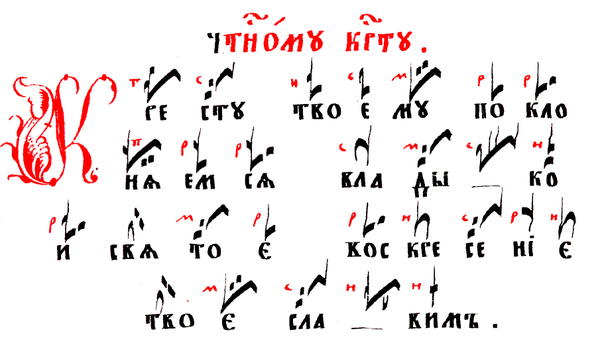| Liturgical Home Page | Orthodox Worship Services | “Proper” Hymns this weekend | Hymns we Commonly Chant |
|
History and Development of Orthodox Liturgical Chant Services in the Orthodox Church are unique in modern times, with everything chanted, or sung, from the beginning to the end by the clergy, the choir(s), and the faithful present. Certainly music provides an element of beauty to the divine services, and on many occasions a service can be memorable for the magnificence of the sacred melodies. It is not the music, however, that is holy or even significant. Rather, the words are sacred and the music or melody is meant to fit the text. This very fact clearly exemplifies the Orthodox theological principle that we are called to change our will and increasingly conform ourselves to the sacred will of God. Orthodox Divine Services are chanted in their entirety by the clergy, the choir(s), and the congregation from the beginning to the end. This is unique in the contemporary era, even though it has been the tradition of the Christian Church from its very inception.It is significant that the melodies and music are not regarded as sacred, nor to be strictly followed. This is unfortunately a very common mistake made by choirs and choir directors in some parishes. It is also something that may puzzle those who encounter the Orthodox Liturgy for the first time. The music certainly adds beauty to the Orthodox Liturgy, and a magnificently-sung Liturgy antiphonally-sung can be a memorable occasion. At the same time, an earnest and pious but off-tune effort to chant the hymns of the day is often just as wonderfully inspiring and unforgettable. The words of the hymns are sacred, passed down faithfully and without change from generation to generation within the Orthodox Church. Much of Orthodox theology is communicated in the hymns, and thus the music must always fit the text, and never the other way around. This practice reflects our Theology, which teaches us that we must deny our own will while continuously striving to do God’s will and abide by the Scriptures and our Sacred Tradition. The Orthodox faith requires change, also called repentance, inviting us to grow spiritually in increasing conformance to the likeness of God. |
||
| Antiquity | ||
|
Chant
in the earliest, New Testament Christian services contained a simple
refrain, or responsorial, sung by the congregation, a tradition that very
naturally evolved from the musical practices of the Jewish synagogue, in
which the cantor improvised charismatic song to intone the Psalms.
This is, perhaps, the first premise of the Orthodox musical tradition: improvisation around a basic melody to faithfully yet freely communicate the message of the faith. This principle along with the subordination of music to text places Orthodox Christian chant at odds with Western musical tradition. It is far more in keeping with the ancient social function of music from antiquity through the Mesopotamian, Egyptian, Hebrew, Greek, and Roman civilizations. In these societies, music supported religious, military, communal or solitary labour as an adjunct to bodily movement (dance, march, game, or work) or to song. “Many centuries were to pass before pleasure in euphonious sound became an end in itself.” (See https://www.britannica.com/art/Western-music). |
||
| Byzantine Chant | ||
|
Byzantine
chant is associated with the period of the Eastern Roman Empire, AD 330 to
1453 (see note below). It developed from the Jewish and Syrian traditions
of the early-Christian Church, and continued to evolve through the
sixteenth century.
Although often associated with the spread of “Greek” Christianity in the east, it is is unrelated to that of ancient Greece (ca. 800-300 BC). In the 20th century attempts have been made to transcribe Byzantine melodies into Western notation, although distorts the sound and, way too often the theological accuracy of the hymns. Note: The Roman Empire (Latin: “Imperium Romanum,” Greek: «Βασιλεία τῶν Ῥωμαίων») was the post-Republican period of ancient Rome from 27 BC to AD 1453. The capitol was in Rome until AD 330 when it was transferred to the city of Byzantium, renamed Constantinople. During the fourth and fifth centuries the organs of imperial government were also gradually moved east principally because of the existential threat to Rome from the depredations of Germanic tribes which led to the Dark Ages (AD 476 to 800). There never was a “Byzantine Empire” since the term was coined in 1557 by the German historian Hieronymus Wolf. |
||
| Slavic or “Russian” Chant | ||
|
Russian
liturgical chant is, broadly speaking, the musical tradition of the
Russian and related Slavic (Ukrainian and Balkan) Orthodox Churches. It
began with the Baptism of the Kievan Rus’ people to Orthodoxy in AD 988.
At the end of the first millenium, Mount Athos was generally regarded as the liturgical and musical conservator of Orthodox Christianity. Monastics from throughout the Eastern Roman Empire and Eastern Europe traveled to the Athonite for musical training and to learn the ways of Orthodox chant. The Kievan Rus’ received both the Orthodox faith and Byzantine chant at their baptism. At first the chanting followed Byzantine melodies adapted to the accentual patterns of the Old Church Slavonic language. In the 14th century native Russian elements began to enter into church music and by the 16th century, Russian chant seems to have lost its links with Byzantine prototypes. An example of old Slavic chant can be listened to here. Znamenny Chant Znamenny. A unique Russian method of musical notation developed in the 15th century, and most technical terms were in Russian as the Greek terms began to disappear. By the end of the 15th century a distinct Rus’ian style, Znamenny, flourished and spread to the north (Novgorod principally) and southwest.
The latter is particularly relevant to parishes in the Orthodox Church in America (OCA) since may of the Eastern European immigrants that brought Orthodoxy to America originated in this region of the former Austro-Hungarian Empire. An example of the Beatitudes sung in Znamenny chant can be listened to here sung by the Saint Tikhon Monastery Choir. An example of Carpatho-Russian chant can be listened to here. Obikhod Chant Obikhod The Obikhod (Обиход церковного пения) is a collection of polyphonic Russian Orthodox liturgical chants forming a major tradition of Russian liturgical music. The original “Obikhod” is the book of rites from the Volokolamsk (near Moscow) monastery composed about 1575, which included traditional liturgical chants. Originally monodic, the Obikhod later developed polyphony. In 1772 the Obikhod was the first compilation of music printed in Russia at Moscow. The common version was extensively revised and standardized by composer Nikolai Rimsky-Korsakov; this version was published as the 1909 edition of the Obikhod, the last before the Russian Revolution. The Obikhod style, and the 1909 edition, was predominately used by the Russian Orthodox Church during the decades of Soviet Union rule in the 20th century, displacing both traditional Russian styles, such as the Ruthenian Prostopinije style, and also the chant traditions of Georgia, Armenia, and Carpatho-Russia. Pyotr Ilyich Tchaikovsky drew from the Obikhod style for his 1812 Overture, as did Nikolai Rimsky-Korsakov in his Russian Easter Festival Overture. The pitch set used in Obikhod chants traditionally consists of four three-note groups. Each note within a group is separated by a whole tone, and each group is separated by a semitone. In the 16th century Rus’ian liturgical tradition began to evolve into northern (Moscow-dominated) and southwest (Kyivan) variants. In the north, Znamenny chant began to grow more elaborate, and the chant itself also became far more melismatic than before. Polyphony (simultaneously combining a number of parts, each forming an individual melody and harmonizing with each other) began to appear during this period in the form of heterophony (the independent variation on a single melody by two or more voices). As practiced in the Russian tradition multiple singers sang the base chant and freely improvised around it while remaining faithful to the core chant. Demestvénny Chant Demestvénny. More elaborate compositions in the Známenny tradition, marked by complexity of rhythm and freedom of melodic structure, flourished in the 17th century especially for hymns sung at the most-solemn feast-day services. These were unique, being outside the traditional eight-tone system, and became regarded as musical works that could be performed in concert rather than in the Divine Services. The term for this category of hymnography is misleading. Demestvénny meant “domestic” singing, in other words those hymns used for the private devotions of households and not for church services. Far from being folk songs, however, Demestvénny chant is not at all suited for domestic use since it requires trained singers and is applied to strictly liturgical texts that would not normally be sung outside of church services. A very beautiful performance of the Hymn to the Mother of God can be listened to here in the Demestvénny tradition sung by the Russian Patriarchate Choir. Orchestration In the 17th century, Russian musicians began to emulate music of Western origin, at first through contacts with Ukrainian and Polish models. German influence became prominent in the 19th century, when various composers emulated the Protestant chorale in Russian church music. There are many well-known examples of church hymns orchestrated by Tchaikovsky (1840-1893), Rimsky-Korsakov (1844-1908), and Rachmaninoff (1873-1943) to name several. A restoration of Russian chant began the early years of the 20th century and continues to reclaim traditional melodies and chanting styles. Kievan Chant Kyivan Tradition. In the Southwestern region around Kyiv – generally and rather broadly what we think of today as Ukraine – the Orthodox Church was confronted and opposed by its Roman Catholic neighbors, a problem that continues to persist in the 21st century. To retain its Orthodox traditions, many schools teaching laymen to sing and read the Church hymns. These schools borrowed from Serbian, Bulgarian, and other Orthodox chant traditions to formed a distinctive Kyivan chant style. Eventually, during the Polish Renaissance (late 15th to late 16th century), the Kyivan Orthodox Church fully adopted the polyphonic style. They retained the Znamenny chant, eight tones (glasy), and scale, but adopted the descant (an independent treble melody usually sung or played above a basic melody) style of their Catholic counterparts. |


